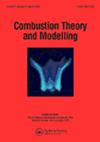The spectral characterisation of reduced order models in chemical kinetic systems
IF 1.6
4区 工程技术
Q4 ENERGY & FUELS
引用次数: 0
Abstract
The size and complexity of multi-scale problems such as those arising in chemical kinetics mechanisms has stimulated the search for methods that reduce the number of species and chemical reactions but retain a desired degree of accuracy. The time-scale characterisation of the multi-scale problem can be carried out on the basis of local information such as the Jacobian matrix of the model problem and its related eigen-system evaluated at one point P of the system trajectory. While the original problem is usually described by ordinary differential equations (ODEs), the reduced order model is described by a reduced number of ODEs and a number of algebraic equations (AEs), that might express one or more physical conservation laws (mass, momentum, energy), or the fact that the long-term dynamics evolves within a so-called Slow Invariant Manifold (SIM). To fully exploit the benefits offered by a reduced order model, it is required that the time scale characterisation of the n-dimensional reduced order model returns an answer consistent and coherent with the time-scale characterisation of the N-dimensional original model. This manuscript discusses a procedure for obtaining the time-scale characterisation of the reduced order model in a manner that is consistent with that of the original problem. While a standard time scale characterisation of the (original) N-dimensional original model can be carried out by evaluating the eigen-system of the ( ) Jacobian matrix of the vector field that defines the system dynamics, the time-scale characterisation of the n-dimensional reduced order model (with n化学动力学系统中降阶模型的谱特征
多尺度问题(如化学动力学机制中出现的问题)的规模和复杂性刺激了对减少物种和化学反应数量但保持所需精度的方法的探索。多尺度问题的时间尺度表征可以基于局部信息来进行,例如在系统轨迹的一个点P处评估的模型问题及其相关特征系统的雅可比矩阵。虽然原始问题通常由常微分方程(ODE)描述,但降阶模型由数量减少的常微分方程和数量减少的代数方程(AE)描述,这些方程可能表示一个或多个物理守恒定律(质量、动量、能量),或者长期动力学在所谓的慢不变流形(SIM)中演化的事实。为了充分利用降阶模型所提供的好处,要求n维降阶模型的时间尺度表征返回与n维原始模型的时间维度表征一致且连贯的答案。本文讨论了以与原始问题一致的方式获得降阶模型的时间尺度特征的过程。虽然(原始)N维原始模型的标准时间尺度表征可以通过评估定义系统动力学的向量场的()雅可比矩阵的特征系统来执行,但N维降阶模型的时间尺度表征(具有N
本文章由计算机程序翻译,如有差异,请以英文原文为准。
求助全文
约1分钟内获得全文
求助全文
来源期刊

Combustion Theory and Modelling
工程技术-工程:化工
CiteScore
3.00
自引率
7.70%
发文量
38
审稿时长
6 months
期刊介绍:
Combustion Theory and Modelling is a leading international journal devoted to the application of mathematical modelling, numerical simulation and experimental techniques to the study of combustion. Articles can cover a wide range of topics, such as: premixed laminar flames, laminar diffusion flames, turbulent combustion, fires, chemical kinetics, pollutant formation, microgravity, materials synthesis, chemical vapour deposition, catalysis, droplet and spray combustion, detonation dynamics, thermal explosions, ignition, energetic materials and propellants, burners and engine combustion. A diverse spectrum of mathematical methods may also be used, including large scale numerical simulation, hybrid computational schemes, front tracking, adaptive mesh refinement, optimized parallel computation, asymptotic methods and singular perturbation techniques, bifurcation theory, optimization methods, dynamical systems theory, cellular automata and discrete methods and probabilistic and statistical methods. Experimental studies that employ intrusive or nonintrusive diagnostics and are published in the Journal should be closely related to theoretical issues, by highlighting fundamental theoretical questions or by providing a sound basis for comparison with theory.
 求助内容:
求助内容: 应助结果提醒方式:
应助结果提醒方式:


